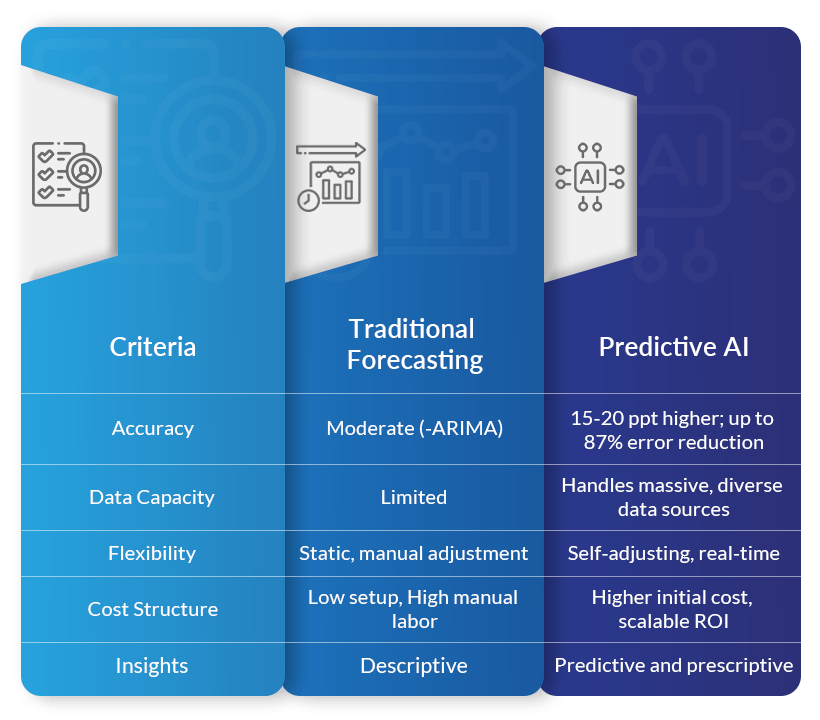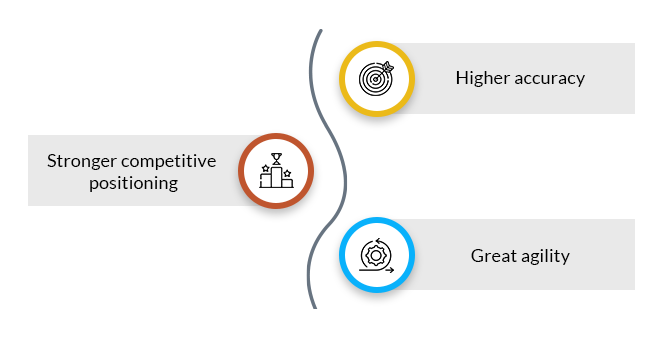
Here’s What You Will Learn in This Blog
- Introduction
- What Is Traditional Forecasting?
- Limitations of traditional forecasting
- What Is Predictive AI?
- Strengths of Predictive AI
- Head-to-Head Comparison
- Real-World Use Cases & Statistics
- Building an AI Strategy for Forecasting
- Case Study Integration Opportunities
- Hybrid Forecasting Models: The Best of Both Worlds
- Measuring ROI and Navigating Challenges
- FAQs
- Conclusion
Introduction
In today’s data-driven era, accurate forecasting is no longer a luxury—it’s a necessity. From anticipating market trends to managing supply chains, how organizations predict the future has a profound influence on their strategic decisions. Traditionally, businesses have relied on statistical models to project trends. However, the rise of Predictive AI and Enterprise AI is revolutionizing this space.
A recent survey by Deloitte reveals that 73% of high-performing businesses are now investing in predictive analytics to improve operational accuracy.
As the volume and complexity of data continue to grow, traditional models are no longer sufficient to meet the needs of modern enterprises. Business leaders must adapt by embracing AI solutions that are not only smarter but also scalable and dynamic.
What Is Traditional Forecasting?
Traditional forecasting relies on statistical methods such as:
- Moving Averages
- Linear Regression
- ARIMA (Auto-Regressive Integrated Moving Average)
These methods analyze historical data to project future outcomes. They are simple, cost-effective, and ideal for scenarios where patterns remain stable over time.
Limitations of traditional forecasting
- Struggles with large data sets and real-time updates
- Inflexible in responding to sudden market shifts
- Relies heavily on human calibration and oversight
- Less accurate in volatile environments
What Is Predictive AI?
Predictive AI utilizes machine learning algorithms, neural networks, and big data to forecast future outcomes. It learns from both structured and unstructured data, adapting over time. Key technologies include:
- Deep Learning
- LSTM (Long Short-Term Memory) Networks
- Natural Language Processing (NLP)
- Automated Feature Engineering
Strengths of Predictive AI
- Continuously improves forecasting accuracy
- Analyzes real-time and high-volume data
- Adjusts to changes dynamically
- Offers scenario-based planning and early risk detection
Head-to-Head Comparison

Ready to evolve your forecasting capabilities?
Empower your business with Enterprise AI and AI Solutions that enable real-time, intelligent decision-making.
Explore AI Solutions with Nsight and discover how our strategy consultations can unlock future-ready performance.
Real-World Use Cases & Statistics
Retail & Supply Chain
Retail giants like Walmart use AI-powered forecasting to make billions of weekly predictions· This has led to smarter inventory decisions and improved demand forecasting.
Weather Forecasting
DeepMind’s GenCast AI model outperformed traditional meteorological systems 97% of the time. AI-powered forecasts are more accurate and timely, which is critical in climate-sensitive sectors.
Enterprise AI Adoption
According to recent industry studies:
49% of tech leaders have fully integrated AI into their operations.
Organizations implementing predictive AI report 20–30% boosts in productivity and improved customer insights
Building an AI Strategy for Forecasting
Crafting a solid AI strategy involves several foundational steps:
1. Evaluate Organizational Readiness
Assess existing infrastructure, data governance, and digital maturity.
Clean, high-quality data is the backbone of predictive analytics.
2. Define Your Business Goals
Identify use cases like sales forecasts, financial projections, and supply chain optimization.
3. Choose the Right AI Solutions
Leverage tools like SAP Analytics Cloud for robust cloud-based predictive modeling.
👉 Learn More About SAP Analytics Cloud
4. Create an Execution Roadmap
Set clear KPIs and ROI metrics.
Integrate AI training, change management, and ethical guidelines into your rollout plan.
Case Study Integration Opportunities
Curious how AI has transformed logistics for a Fortune 500 company?
Check our AI Solutions for real-world examples and success metrics.
Want to understand how the SAP Analytics Cloud powers predictive planning across departments?
Hybrid Forecasting Models: The Best of Both Worlds
Some sectors combine the reliability of traditional models with the flexibility of AI. For example:
Energy companies use traditional demand forecasting models but apply AI for weather and consumption variability.
Financial institutions overlay AI-driven sentiment analysis on conventional economic indicators.
This hybrid approach provides robustness, especially in compliance-sensitive or high-stakes environments.
Measuring ROI and Navigating Challenges
Key ROI Drivers:
- Reduced forecast error translates directly to cost savings
- Faster response times improve agility
- Granular insights enhance marketing and inventory strategies
Common Roadblocks:
- Poor data quality
- Resistance to change
- Skill shortages in data science
Solutions include:
- Poor data quality
- Resistance to change
- Skill shortages in data science
Conclusion The Strategic Advantage of Predictive AI
The shift from traditional forecasting to Predictive AI isn’t just a technological upgrade—it’s a strategic transformation. Moreover, Gartner reports that organizations using AI for forecasting can reduce forecasting errors by up to 50%, resulting in significant cost savings and improved agility.
Organizations that embed AI solutions into their forecasting processes gain:

Whether you’re a CIO, CFO, or digital strategist, now is the time to reimagine forecasting through the lens of Enterprise AI.
Frequently Asked Questions (FAQs)
Traditional methods remain effective for stable, linear trend scenarios with limited data variability.
Structured historical data, real-time transactional data, and even unstructured social or sensor data can be used for predictive AI models.
Depending on complexity and infrastructure, implementation can take 3–12 months with phased rollouts and ongoing refinement.
Ready to build your AI Strategy?
Connect with our experts today and begin your journey toward predictive precision and operational excellence.
About the Author

Deepak Agarwal, a digital and AI transformation expert with over 16 years of experience, is dedicated to assisting clients from various industries in realizing their business goals through digital innovation. He has a deep understanding of the unique challenges and opportunities, and he is passionate about using cutting-edge technologies to solve real-world business problems. He has a proven track record of success in helping clients improve operations, increase efficiency, and reduce costs through emerging technologies.





